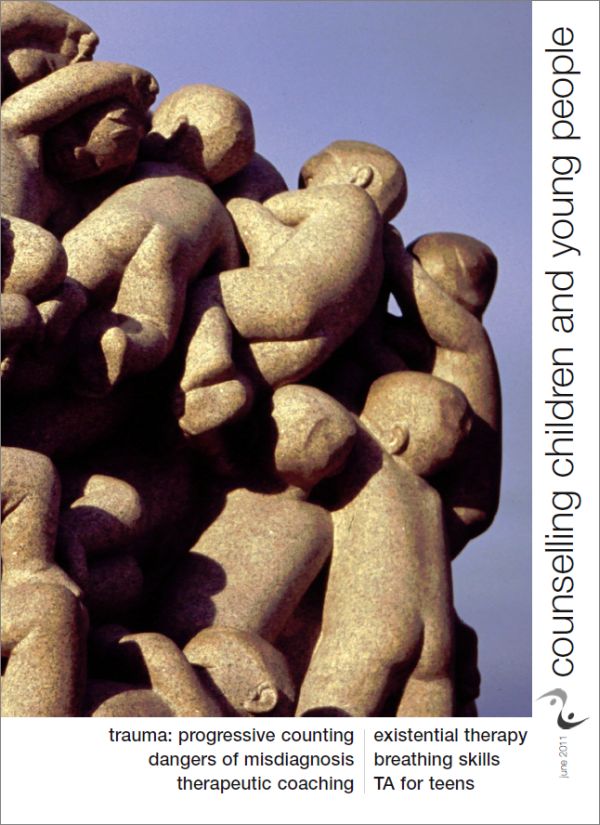In this issue
Misunderstood and misdiagnosed (free article)
Children with developmental difficulties often fail to gain access to appropriate services, says Graham Music
Progressive counting
A new trauma treatment that is simple and effective. Ricky Greenwald reports
On breathing
Dawnie Browne believes that awareness of our breath benefits client work
Online identity formation
Lindsay Dobson writes about the counselling work at kooth.com
TA meets teenagers
Freda Anning finds a welcome for ego states and transactions at a comprehensive school
Destination PhD
Val Taylor enters the second year of her research degree, asking, hopefully, the right questions
Existential therapy with children
Children need to be firmly rooted in their relational existence, says Chris Scalzo, in order to make responsible choices
Unseen voices
Dismissing children’s narratives as ‘just imagination’ is damaging. Kate Adams explains
Therapeutic coaching
Frances Masters offers a fusion of coaching, counselling and psycho-education to young people
In my opinion
Bridget Sheehan makes the case for a bottom-up approach in schools
EFT for managing stress at home
A book extract by Nancy Gnecco detailing how to use Emotional Freedom Techniques to help parents deal with their own and their children’s stress
From the chair

Not all articles from this issue are available online. Divisional members and subscribers can download the pdf from the BACP Children, Young People and Families archive.
Welcome from the editor
As I walked along an expanse of sandy beach recently, I pondered on the many footsteps that would disappear with each tide, erasing those people’s evidence of existence. And this reminded me of my clients over the last 10 years. Their names have vanished from my mind, but the encounters live on inside me, having contributed to my professional development by fuelling new understanding of young people and my therapeutic work.
OK, I told myself, that’s a great idea, but trite. The words positively tripped off the tongue. What I needed to ask myself is: in exactly which way has my work developed over the years. And the specific words that accurately sum it up are ‘gut instinct’, ‘flexibility’, and ‘willingness to learn from client to client’ – all based in my theory, of course, but not kowtowing to manualised evidence-based treatment. (The phrase didn’t exist when I first started, anyway, which shows what gigantic wheels the ‘proof’ wagon has recently rolled on.)
In this respect, I quite like Chris Scalzo’s article on existentialism, which at first seems hard to differentiate from the person-centred approach. But when it comes to acknowledging and accepting the two givens (birth and death – plus a few others for young people) and emphasising relationship, responsibility and making choices, then that really does free up everything else. Existentialism, in one sense, seems to give a carte blanche to work in the most intuitively creative way we can, grounded in the philosophy and theory of the model. Proper training plus seat-of-the-pants.
But as we move towards establishing good guidelines for the training of CYP counsellors, what do we really mean by ‘proper training’? Trained to work only to the initial model, and/or to evidence-based systems, and/or from a manual? Or trained to know the theory and understand how to work creatively? Which doesn’t necessarily mean handing out worksheets from the plethora of books on sale or using someone else’s games, though they have their part to play. What I understand by creativity (and by my chosen words of ‘gut instinct’ and ‘flexibility’ is the sort mentioned by Duncan and Miller1: ‘Experienced therapists know that the work requires the tailoring of any approach to a particular client’s unique circumstances. The nuances and creativity of an actual encounter flow from the moment-to-moment interaction of the participants – from the client, relational and therapist idiographic mix – not from step A to step B on page 39.’
Now this is what we learn as we go, as we develop as counsellors and therapists – but surely there must be a way to introduce such competence, by degrees, into training for counsellors working with young people? In only 10 years I have met far too many rigidly ‘correct’ counsellors, checking formalities with their supervisors and self-righteously toeing the official line from session to session. Let’s erase that kind of work and revel in opportunities to forget page 39, even as the sand forgets the footprints that covered it. Every article in this issue points that way forward.
Eleanor Patrick
Editor
Reference
1 Quoted in Haen C. (ed) Engaging boys in treatment. (p25) London: Routledge; 2011.
